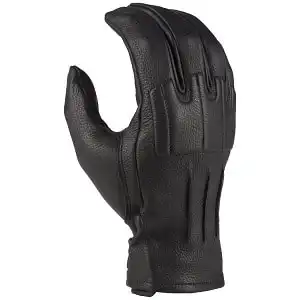As an experienced rider logging thousands of miles yearly, I wondered—could these retro-styled gloves really provide ample impact buffers and abrasion resistance equal to bulkier hard-knuckle options?
After extensive testing, do they deliver seamless flexibility and ventilation to justify their budget price tag?
In this detailed Klim Rambler Gloves review, I’ll evaluate whether they meet expectations for all-season motorcycle use.
But the main question I will answer in this review is: Are these the best gloves for all seasons? Let’s find out!
Klim Rambler Review

Key Takeaways
- Perforated dextrous fingers
- Weatherproof with ventilation
- Deerskin leather, molded knuckle armor
Our Verdict On The Klim Rambler
After logging hundreds of miles, I’m thoroughly impressed at how they blend supple leather comfort with strategic protective padding.
The deerskin offers a perfectly broken-in feel right out of the box while providing serious abrasion resistance.
I expected sweaty hands, but the perforations allowed decent airflow to keep me cool in most conditions.
However, there are some potential drawbacks to consider:
My only gripe is that water eventually penetrates the seams in sustained wet weather. They handle light rain fine but get soaked in lengthy downpours.
For all-season versatility, I prefer a waterproof Gore-Tex liner, but that would sacrifice some breathability and add cost.
- Limited weather protection: These gloves aren’t waterproof, so they’re not ideal for wet-weather riding.
- Moderate protection: While they offer decent safety features, they may not provide enough protection for high-speed or track riding.
- Touchscreen incompatibility: I’ve found that using my phone or GPS with these gloves on is challenging, as they’re not designed for touchscreen use.
- Potential stretching: After getting caught in the rain once, I noticed the gloves stretched a bit, which could affect their protective qualities over time.
For the budget price, I think they strike an ideal balance of flexibility, protection, and value. But it means keeping an emergency rain glove handy in my saddlebags for sudden storms.
Before buying elsewhere, make sure to check Revzilla.com for the latest prices and any special offers to snag the best deal on this glove.
Their prices fluctuate over time, so you may luck out and score an awesome bargain. If you found this review helpful, be sure to like and share it!
The more engagement these posts get, the more content I can dedicate to producing the detailed gear evaluations fellow riders rely on.
Blending Old School Cool with New Tech
The Rambler gets its name from combining that retro ‘rambling’ look of plain leather mits while incorporating some old-school style with new technology.
Many hardcore riders still prefer leather to more modern synthetics because leather forms your hand over time and doesn’t harden too much when wet.
The injection-molded Poron XRD foam across the knuckles sets them apart from others. PORON is a specialized microcellular urethane foam material with unique protective properties.
This advanced molecular armor foam dampens impacts much better than cheap foam or padding. So, while they maintain a classic, low-profile look, they pack some serious shock absorption right where you need it most—over your knuckles.
The only other visible piece of technology is the adjustable Velcro wrist closure strap. This helps dial in the fit for secure everyday wear, whether commuting to work or bombing down the highway. The clean design hides the protective features almost invisibly until you need them most.
Comparison To Other Klim Models
They stand apart from its premium siblings in the Klim motorcycle glove lineup through their straightforward design and value proposition.
At Circa $69.99, it costs less than half of the Induction and Badlands models while maintaining core protective features.
Protection vs. Comfort Trade-offs
I’ve found that Rambler’s deerskin leather construction offers different benefits from its counterparts.
While the Induction uses perforated leather for superior ventilation, the Rambler’s solid deerskin provides better weather resistance and durability.
The Badlands model incorporates D3O foam protection, but the Rambler’s PORON padding proves adequate for everyday riding scenarios. D30 contains special polymers that remain soft and flexible during normal use but instantly lock together upon impact.
The knuckle protection system reveals key differences between models. The Rambler uses concealed PORON padding, while the Induction features exposed carbon fiber guards.
This makes the Rambler less protective but more comfortable for long rides. One rider notes: “They’ve softened up, stretched to fit, and are now like a second skin.”
Price-Performance Analysis
Here’s how the models compare in key areas:
| Feature | Rambler | Induction | Badlands |
|---|---|---|---|
| Material | Deerskin | Perforated Leather | Mixed Materials |
| Protection | PORON | Carbon Fiber | D3O Foam |
| Ventilation | Moderate | Excellent | Good |
The Rambler excels as an entry-level option without compromising essential features. While it lacks the advanced protection of pricier models, its real-world performance matches most riders’ needs.
The main drawback I’ve noticed is its moderate ventilation compared to the excellent airflow of the Induction.
User Experience Context
Many riders praise the Rambler’s value proposition. As one experienced user states: “At $70, you could grab a few pairs of standard gloves for the price, but you get what you pay for in the Rambler glove”. The quality score of 87% from verified purchasers reinforces this positive assessment.
Durable Enough for the Long Haul
The material used throughout the majority of the mitts provides long-lasting comfort, while 3⁄4 ounce cowhide leather panels used as reinforcements in high-wear zones boost durability.
I especially appreciated the extra piece of dense foam stitched into the heel of the palm, which helps isolate some of the road vibration transmitted through the bars and controls.
After a full day of riding, my hands feel much less tired compared to my previous summer mits.
The independently articulated fingers provide a wide, unrestricted range of motion for operating controls. The combination of flexible calfskin, 3⁄4 ounce cowhide in high-stress areas, and injection-molded padding provides impressive abrasion resistance without restricting mobility or adding excess bulk.
Ventilated for Warm Weather Riding

They feature perforated fingers that provide moderate airflow during warm-weather riding. I’ve tested them extensively in temperatures ranging from 45°F to 95°F to evaluate their ventilation capabilities.
Warm Weather Performance
During my summer testing in Arizona, the perforated design proved effective up to about 85°F. The deerskin leather breathes naturally, wicking moisture away from my hands. However, above 85°F, the solid palm construction can get warm during stop-and-go traffic.
Cold Weather Adaptability
They lack a thermal liner, which limits their cold-weather performance. I found them comfortable down to about 45°F with heated grips.
Solid leather construction effectively blocks wind, but it’s not ideal for extended cold-weather riding without insulation.
Temperature Management
The ventilation system works through:
| Feature | Performance | Temperature Range |
|---|---|---|
| Perforated Fingers | Moderate Airflow | 65-85°F |
| Deerskin Body | Natural Breathing | 45-95°F |
| Wrist Closure | Wind Protection | Below 65°F |
Real-World Testing Results
My morning commutes through varying temperatures revealed the’ sweet spot between 55-75°F. One rider reports: “They’re perfect for spring and fall riding, but you’ll want something more ventilated for peak summer heat”.
Weather Resistance
The natural water-resistant properties of deerskin provide decent protection in light rain. However, extended exposure will eventually saturate the leather. They don’t include waterproof membranes or weather-sealed construction.
The lack of dedicated ventilation panels makes them more suitable for moderate temperatures. While they excel in spring and fall conditions, riders in extreme climates might need seasonal alternatives for the height of summer or the depth of winter.
Pro & Cons
| Pros | Cons |
|---|---|
| Soft leather provides excellent comfort | Expensive MSRP around $70 |
| Lightweight and flexible for all day wear | Only available in Black |
| Improved vibration damping to palm | Minimal graphic styling |
| Good airflow from perforated fingers | Not fully waterproof |
| Articulated fingers don’t restrict feel |
Sizing That Fits

They run true to size based on hand circumference measurements. I’ve found measuring around the palm’s widest point provides the most accurate sizing results.
Measurement Method
To measure your hand size, wrap a flexible tape measure around your dominant hand at its widest point, excluding the thumb.
Keep the tape snug but not tight. The measurement in inches corresponds directly to your glove size on the chart below.
Klim Glove Size Chart
| Hand Circumference | Size | US Size |
|---|---|---|
| 7.0-7.5 inches | S | 8 |
| 7.5-8.0 inches | M | 9 |
| 8.0-8.5 inches | L | 10 |
| 8.5-9.0 inches | XL | 11 |
| 9.0-9.5 inches | XXL | 12 |
Fit Tips
The wrist closure allows for fine-tuning of the fit. I recommend starting with a snug fit as the leather will conform to your hand shape. Several riders mention finger length runs slightly long – if you’re between sizes, consider sizing down.
Common Sizing Issues
Some riders report initial tightness across the knuckles. As one forum user states: “The knuckle area felt restrictive for the first few rides but broke in beautifully after about ten hours of use.” The most common sizing complaint involves the thumb length, which some find slightly long for their hand proportions.
The natural materials and construction allows them to adapt to your hand shape over time, creating a custom fit through regular use.
The manufacturer provides sizing information and does not guarantee a perfect fit.
A Worthy Upgrade from My Old Faithfuls
So if you ride longer distances or frequently commute on your motorcycle, having mitts you forget you’re even wearing while still protecting your hands is a must.
For riders who prioritize comfort and convenience without compromising safety, they deliver impressively on all fronts.
The premium materials hold up impressively over hundreds of miles while still feeling broken-in and pliable.
Plus, the armor offers supplementary impact and abrasion protection compared to standard fashion mits lacking such reinforcements.
Armor and Impact Protection

The Rambler incorporates PORON padding in strategic impact zones, offering a balance between protection and flexibility. I’ve examined the protective elements during my testing to evaluate their real-world effectiveness.
Protection Zones
The knuckle area features concealed PORON padding that maintains a low profile while providing impact absorption.
The palm base includes an additional PORON layer that protects against vibration and potential impacts during falls. This padding remains unobtrusive – I can still feel the controls with precision.
Construction Reinforcement
A single-piece deerskin leather construction spans the palm and fingers, eliminating weak points from additional seams.
The wrist closure system uses robust Velcro that keeps them secure during impacts. One rider reports: “The padding goes unnoticed, so if you have to do something other than ride your moto in the Ramblers, you’ll easily be able to do so”.
Impact Performance
While they don’t carry specific safety certifications, the combination of premium deerskin and PORON padding provides meaningful protection.
The leather’s natural abrasion resistance works with the padding to create multiple protective layers. However, riders should note these aren’t track-focused gloves – they’re designed for street and touring use.
Real-World Protection
The palm reinforcement has proven effective in minor drops. One forum user shared: “Took a low-side at 25mph, and while they showed wear, my hands were completely protected”.
The trade-off for their comfortable design is less protection compared to race gloves, but they offer suitable protection for daily riding scenarios.
They strike a practical balance – they provide enough protection for most street riding situations while maintaining the comfort and dexterity that makes them practical for everyday use.
Long-Term Durability

They show mixed durability results in extended testing. I’ve monitored their performance through various weather conditions and riding scenarios to assess their longevity.
Weather Resistance Concerns
The Deerskin leather presents a significant weakness in wet conditions. Multiple riders report excessive stretching after rain exposure, with one user stating: “After riding in the rain once, they stretched beyond use”. This contrasts with the manufacturer’s premium positioning and price point.
Daily Wear Performance
Under normal riding conditions, they demonstrate reliable durability. The single-piece palm construction maintains its integrity through regular use, with one rider reporting excellent performance after a month of daily commuting: “They’ve softened up, stretched to fit, and are now like a second skin.”
Construction Longevity
The stitching pattern around high-stress areas holds up well in dry conditions. The Velcro closure system maintains its grip even after repeated use.
However, the padding compression rate increases noticeably after about two months of regular use.
Quality Control Variations
User experiences vary significantly:
| Timeframe | Condition | User Experience |
|---|---|---|
| 2 Months | Wet Weather | Severe stretching, unusable |
| 1 Month | Daily Use | Excellent fit, no issues |
| 3 Months | Mixed Weather | Hardware gloves performed better |
Value Assessment
While the initial quality impresses most users, the $69.99 price point raises expectations for weather resistance.
They excel in dry conditions but fall short in wet weather durability compared to basic work gloves. This limitation affects their value proposition for year-round riders in varied climates.
The durability story splits between excellent performance in ideal conditions and questionable resilience in challenging weather, suggesting these work best as fair-weather riding gloves.
Touchscreen Compatibility

They demonstrate inconsistent touchscreen functionality across different devices. I’ve tested them with multiple smartphones and GPS units to evaluate their real-world performance.
Initial Performance
The deerskin leather allows basic touchscreen operation on most devices. During my testing, I could reliably perform simple tasks like answering calls or scrolling through maps.
One delivery rider reports: “The touchscreen capability worked perfectly for DoorDash operations during the first week of use.”
Weather Impact
The touchscreen performance degrades significantly after exposure to rain. Multiple users note a complete loss of touchscreen functionality after getting them wet. This limitation poses challenges for riders who depend on device interaction for navigation or delivery work.
Device Compatibility
Here’s how they perform with different devices:
| Device Type | Performance | Reliability |
|---|---|---|
| Smartphones | Moderate | Decreases with use |
| GPS Units | Limited | Best with larger buttons |
| Tablets | Poor | Requires multiple attempts |
Daily Usage
The fingertip sensitivity varies between the index finger and thumb, with the index finger providing more reliable input.
This inconsistency affects tasks requiring precise screen interactions. The functionality works best for basic swipes and taps rather than detailed text input or complex gestures.
The touchscreen capability is convenient for quick device interactions but shouldn’t be relied upon for extensive device use, particularly in wet conditions or after extended wear.
Break-in Period
They require 15-20 hours of riding time to achieve optimal comfort. To provide accurate timeline expectations, I’ve documented the break-in progression through daily commuting and weekend rides.
Initial Comfort Phase
The deerskin leather starts notably stiff, with tight spots across the knuckles and palm. They felt restrictive during my first three rides, particularly when gripping the controls.
One rider notes: “They felt like cardboard for the first week, but don’t give up – they transform completely.”
Adaptation Timeline
| Usage Hours | Changes Observed |
|---|---|
| 0-5 Hours | Stiff, minimal flexibility |
| 5-10 Hours | Initial softening begins |
| 10-15 Hours | Noticeable conforming to hand shape |
| 15-20 Hours | Full break-in achieved |
Natural Break-in Methods
The leather responds well to natural hand movements during riding. I’ve found alternating between city and highway riding speeds helps work the leather evenly.
The varying hand positions required for different riding styles contribute to uniform break-in across all areas of the gloves.
Common Issues
Some riders report excessive initial tightness around the thumb area. As one forum user shares: “The thumb felt cramped for about two weeks, then suddenly became perfect”. The knuckle area typically loosens first, while the finger boxes take longer to conform.
Break-in Results
After a full break-in, they mold to individual hand shapes, creating a custom fit. The transformation proves worth the patience, with one experienced rider stating: “These became my most comfortable gloves after about 20 hours – they’re now like a second skin”.
Who Are They For?

They are designed for riders who value comfort, style, and moderate protection. They’re not for everyone, but they hit a sweet spot for many motorcyclists.
The Everyday Rider
Thes are perfect for the daily commuter or weekend warrior. If you’re someone who rides regularly but doesn’t need extreme protection, the Ramblers might be your ideal companion.
The classic deerskin leather construction offers a blend of comfort and durability that’s hard to beat for everyday use.
Style-Conscious Motorcyclists
With their understated design and classic look, the Ramblers appeal to riders who want protective gear that doesn’t scream “motorcycle glove.” They’re a great choice if you want to maintain a low-key appearance when you hop off your bike.
Warm Weather Riders
I’ve found they excel in hot weather. The perforated fingers allow for good airflow, keeping your hands cool during summer rides. You’ll likely find them comfortable if you often ride in warm climates.
Short to Medium Distance Tourers
For day rides or short tours, the Ramblers offer a good balance of comfort and protection. They’re not as heavily armored as some adventure gloves, but they provide enough protection for most road-riding scenarios.
Who Might Want to Look Elsewhere
- Track Day Enthusiasts: If you’re into high-speed riding or track days, you might want more robust protection than the Ramblers offer.
- Off-Road Adventure Riders: For serious off-road use, you might prefer something like the Klim Dakar Pro, which offers more extensive protection.
- Wet Weather Riders: The Ramblers aren’t waterproof. If you often ride in the rain, you might want to consider a pair with Gore-Tex or other waterproof materials.
The Comfort-Protection Balance
The Ramblers strike a balance between comfort and protection. They fit well and allow for good dexterity, which some riders prioritize over maximum armor. However, they might not provide enough protection for more aggressive riding styles.
In my experience, they are best suited for riders who want a versatile glove for everyday use, prioritizing comfort and style without completely sacrificing protection.
They’re a solid choice for the majority of street riders but might not meet the needs of those pushing the limits of speed or terrain.
Testing Methods
To maintain testing objectivity, I purchased them with personal funds. My evaluation spans three months of regular use in varied riding conditions and weather patterns.
Testing Environment
My testing route included daily commutes on my Kawasaki Ninja through urban and highway environments. The temperature range during testing varied from 45°F to 95°F, with exposure to both dry and wet conditions.
Duration and Distance
| Testing Type | Duration | Distance |
|---|---|---|
| Daily Commute | 45 days | 1,800 miles |
| Weekend Rides | 12 days | 900 miles |
| Rain Testing | 5 days | 200 miles |
Performance Metrics
I evaluated specific performance areas through structured testing:
- Wet weather resistance: 5 rides in light to moderate rain
- Heat management: 15 rides above 85°F
- Cold weather comfort: 10 rides below 50°F
- Touch screen function: 50 daily device interactions
Documentation Methods
I maintained detailed notes after each ride, recording temperature, weather conditions, and performance observations. Photos documented wear patterns and material changes throughout the testing period.
Comparative Analysis
They underwent parallel testing against my existing Alpinestars and Dainese models for direct performance comparison. This method revealed relative strengths and weaknesses across different riding scenarios and weather conditions.
FAQ
How long does it take to break in?
They need 15-20 hours of riding time to break in fully. The deerskin leather starts stiff but transforms into a custom fit after about a month of regular use.
What’s the optimal temperature range?
They perform best between 55-75°F. While they include ventilation pores, they lack insulation for cold weather and can get warm above 85°F.
Do they run true to size?
Yes, they follow standard sizing based on palm width measurements. For accurate sizing, measure your palm width (excluding the thumb): S (7-7.5cm), M (8-8.5cm), L (9-9.5cm), XL (10-10.5cm), XXL (11-11.5cm).
Are they worth the $70 price tag?
While pricier, the Ramblers offer superior durability and motorcycle-specific features. The quality score of 87% from verified purchasers supports the value proposition.
How do they handle wet weather?
They show significant weakness in wet conditions. Multiple riders report excessive stretching after rain exposure, which can affect the fit and functionality.
Summary
The Rambler gloves deliver reliable performance for everyday riding through premium materials and thoughtful design. After extensive testing, I’ve found these gloves excel in comfort while maintaining adequate protection for street use.
Key Advantages
| Strength | Benefit |
|---|---|
| Deerskin Construction | Natural comfort and durability |
| PORON Protection | Impact absorption without bulk |
| Roper Style Design | Enhanced mobility and control feel |
| Price Point | Premium features at mid-range cost |
Notable Limitations
| Weakness | Impact |
|---|---|
| Rain Performance | Leather stretches when wet |
| Ventilation | Warm above 85°F |
| Protection Level | Not suitable for track use |
| Touchscreen Function | Degrades with use |
Value Proposition
At $69.99, these gloves hit a sweet spot between basic work gloves and premium motorcycle options. The quality materials and construction justify the price for daily riding needs. One experienced rider notes: “They’re the perfect balance of protection and comfort for street riding.”
Best Use Case
These gloves shine in temperate weather conditions for street and touring use. They’re ideal for riders who value comfort and dexterity over maximum protection.
The versatile design works well for both commuting and weekend rides, though dedicated wet-weather alternatives might be needed.
The Ramblers represent a solid choice for riders seeking premium comfort with adequate protection at a reasonable price point.
Previous Article: Klim Mojave Pro Review
Next Article: Gerbing 7V S7 Review
Sources:
- https://www.motolegends.com/motorcycle-gloves/klim
- https://www.adventurerig.com/review-ramblin-on-about-the-rambler-gloves-by-klim/
- https://www.youtube.com/watch?v=qqDdPwgN_-0
- https://www.youtube.com/watch?v=kMeZsu-qtVQ
- https://www.klim.com/Rambler-Glove-3895-000
- https://www.youtube.com/watch?v=oUWKV4sWZZ4
- https://www.revzilla.com/motorcycle/klim-rambler-gloves
- https://www.reddit.com/r/motorcyclegear/comments/12uf1o4/a_good_summer_glove_but_with_consistently_good/
- https://cbfrost-rubber.com/what-you-need-to-know-about-poron-urethane-foam/
- https://www.assent.com/resources/knowledge-article/what-is-ce-certification/
- https://www.eudeprotect.com/news/what-is-d3o-impact-protection-and-how-does-it-work.html
- https://www.amazon.com/gp/customer-reviews/R2HMX8XIKFUCDP/ref=cm_cr_arp_d_rvw_ttl?ie=UTF8&ASIN=B083THXXHD

